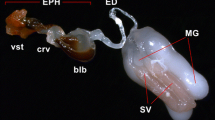Summary
When the spermathecal glands are removed from young unmated queens and they are then naturally mated or artificially inseminated, only a small number of spermatozoa reach the spermatheca. Turgor of the spermatheca is at the same time reduced. Removal of one branch of the gland has very little effect.
When intact queens are inseminated with damaged spermatozoa, the spermatheca remains almost empty. Paralysis of the skeletal muscles in the queens abdomen caused by Microbracon poison results in a sharp reduction of sperm entering the spermatheca. Under such conditions, the sperm is not removed from the oviducts.
From these experiments it is concluded, that transfer of spermatozoa out of the oviducts into the spermatheca is a complex process in which the muscles of the queen, as well as the fluid of the spermatheca and it's glands, and the individual movements of the spermatozoa take part.
Zusammenfassung
Werden bei unbegatteten Jungköniginnen die Spermathekaldrüsen operativ entfernt, dann gelangt nach natürlicher Paarung oder instrumenteller Insemination nur eine geringe Zahl von Spermatozoen in die Spermatheka, außerdem sinkt der Turgor der Samenblase; die Entfernung nur eines Drüsenastes hat kaum einen Effekt. Werden intakte Königinnen mit geschädigten Spermatozoen besamt, dann bleibt die Spermatheka fast leer.
Nach Lähmung der Skelettmuskulatur der Königin durch Microbracon-Gift wird ebenfalls die Füllung der Spermatheka stark reduziert, und das Sperma wird nicht aus den Ovidukten entleert.
Aus diesen Experimenten ergibt sich, daß der Transfer der Spermatozoen aus den Ovidukten in die Spermatheka als ein komplexer Vorgang zu verstehen ist, an dem sowohl die Muskulatur der Königin, die Flüssigkeit der Spermatheka und ihrer Drüse sowie die Eigenbewegungen der Spermatozoen beteiligt sind.
Similar content being viewed by others
Literatur
Beard, R. L.: Insect toxins and venoms. Ann. Rev. Entomol. 8, 1–18 (1963).
Berlepsch, A. v.: Die Biene und ihre Zucht mit beweglichen Waben in Gegenden ohne Spätsommertracht. Mannheim: G. Schneider 1873.
Bishop, G. H.: Fertilization in the honeybee. J. exp. Zool. 31, 225–286 (1920).
Bresslau, E.: Der Samenblasengang der Bienenkönigin. Zool. Anz. 29, 299–325 (1905).
Buttel-Reepen, H. v.: Leben und Wesen der Bienen. Braunschweig: Vieweg & Sohn 1915.
Cale, D. H., Gowen, J. W.: Gamete-backcross matings in the honeybee. Genetics 50, 1443–1446 (1964).
Davey, K. G.: The migration of spermatozoa in the female of Rhodnius prolixus Stahl. J. exp. Biol. 35, 694–701 (1958).
—: Reproduction in the Insects. London: Oliver & Boyd 1965.
Koeniger, G.: Experimenteller Beitrag zur Physiologie der Spermatheka der Bienenkönigin (Apis mellifica L.). Diss, Naturwiss. Fak. Frankfurt a.M. 1968.
—: Bedeutung der Tracheenhülle und der Anhangdrüse der Spermatheka für die Befruchtungsfähigkeit der Spermatozoen in der Bienenkönigin (Apis mellifica L.). Apidologie 1, 55–71 (1970).
Lensky, Y., Schindler, H.: Motility and reversible inactivation of honeybee spermatozoa in vivo and in vitro. Ann. Abeille 10, 5–16 (1967).
Nonidez, J. F.: Internal phenomena of reproduction in Drosophila. Biol. Bull. 39, 210–230 (1920).
Omura, S.: Structure and function of the female genital system of Bombyx mori, with special reference to the mechanism of fertilization. J. Fac. Agr. Hokkaido Imp. Univ. 40, 111–128 (1938).
Piek, T.: Site of action of venom of Microbracon hebetor Say (Braconidae, Hymenoptera). J. Insect Physiol. 12, 561–568 (1966).
Ruttner, F.: Zur Frage der Spermaübertragung bei der Bienenkönigin. Ins. soc. 3, 351–359 (1956).
Vesely, V.: Retention of semen in the lateral oviducts of artificially inseminated honey bee queens (Apis mellifera L.). Acta ent. bohemoslovaca 67, 83–92 (1970).
Weidner, H.: Beiträge zur Morphologie und Physiologie des Genitalapparates der weiblichen Lepidopteren. Z. angew. Entomol. 21, 239–290 (1834).
Woyke, J.: Natural and artificial insemination of queen honey bees. Pszczelnicze Zeszyty Nauk. 4, 183–275 (1960).
Author information
Authors and Affiliations
Additional information
Mit Unterstützung der Deutschen Forschungsgemeinschaft.
Rights and permissions
About this article
Cite this article
Ruttner, F., Koeniger, G. Die Füllung der Spermatheka der Bienenkönigin. Z. vergl. Physiologie 72, 411–422 (1971). https://doi.org/10.1007/BF00300712
Received:
Issue Date:
DOI: https://doi.org/10.1007/BF00300712




